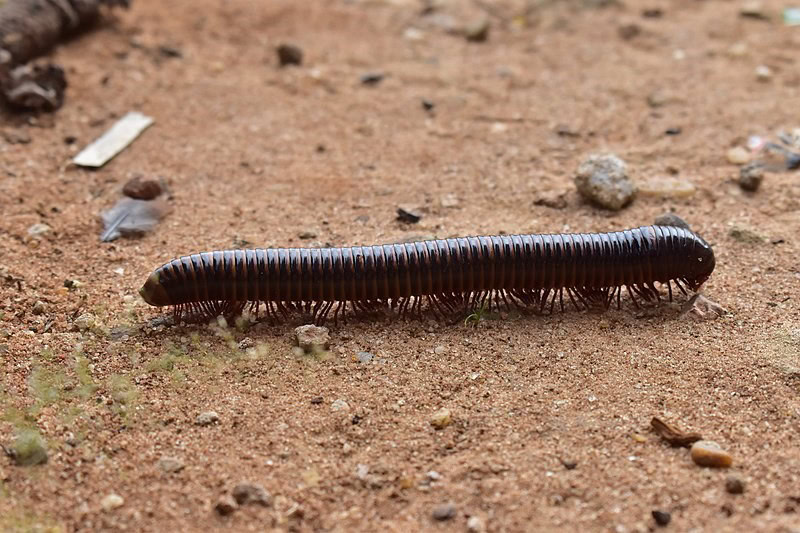Millipedes
What is a Millipede?
Millipedes belong to the class Diplopoda and are easily recognizable by their elongated bodies composed of many segments, each with two pairs of legs. They primarily feed on decomposing organic matter and play an essential role in the decomposition of natural waste. However, their intrusion into human habitats can cause discomfort.
How to Identify Millipedes?
Millipedes, with their diversity in size and color, share a distinctive feature: a long, segmented body supported by numerous pairs of legs, giving them a unique appearance. These creatures move with a characteristic slowness and prefer humid environments, such as bathrooms, basements, and areas around house foundations, where moisture is more conducive to their survival. Their constant search for humidity drives them into homes, creating situations where their numbers can quickly become overwhelming.

Additional Information on Millipedes
Pest Type
Arthropod. Millipedes are distinguished by their classification in the animal kingdom, belonging to the phylum Arthropoda, characterized by an exoskeleton, a segmented body, and numerous pairs of legs.
Appearance
They have elongated, segmented bodies, typically brown or black, with each segment bearing two pairs of legs. Their size can vary significantly, with some specimens reaching up to 12 inches in tropical species, although most millipedes found in temperate areas are less than 4 inches long.
Lifespan
The lifespan of millipedes can be surprising, with some individuals living up to 7 years or more, depending on environmental conditions and food availability.
Habitat
They favor humid and shaded environments for their habitat, such as under stones, decomposing wood, or in soil rich in organic matter, where moisture is constant and food is plentiful.
Diet
Millipedes’ diet mainly consists of decomposing organic matter. They play a crucial ecological role by contributing to decomposition and nutrient cycling.
Life Cycle
Millipedes undergo simple metamorphosis during their development, starting from the egg and passing through several larval stages resembling adults but with fewer segments and pairs of legs. With each molt, they add segments until they reach maturity.
Do I Have a Millipede Problem?
Signs of a Millipede Infestation
- Damage Types: Millipedes can cause damage to indoor plants by feeding on their roots and leaves, and they may also invade stored goods, particularly those kept in damp areas.
- Presence: Frequent sightings of millipedes, especially in humid areas like bathrooms, basements, and around house foundations, indicate a potential infestation.
- Larvae and Pupae: Although millipedes do not have a pupal stage, their presence can be indicated by the sight of juvenile millipedes, which look like smaller versions of adults but with fewer legs and segments.
- Excrement: Millipede droppings are small and can be found near infested areas, contributing to the overall mess and potential damage caused by an infestation.


Risks Associated with Millipedes
Although millipedes do not pose an immediate threat to human health, their ability to enter living spaces in large numbers can cause concern and discomfort. These mainly harmless arthropods can nevertheless cause significant nuisance when they invade homes in search of moisture.
Exterminapro recognizes the need for an effective and respectful approach to managing these invasions, offering extermination and prevention strategies tailored to each situation. By using our services, you choose a professional solution to address the millipede problem, ensuring the comfort and tranquility of your home.
Treatments to Get Rid of Millipedes
Preventing Millipede Infestations
- Ensuring good ventilation in areas prone to humidity such as bathrooms, basements, and kitchens helps reduce your home’s attractiveness to millipedes seeking a humid habitat.
- Sealing cracks and openings that serve as entry points for millipedes using caulk and screens can effectively prevent their access inside the house.
Types of Treatments to Control Millipedes
- Chemical Treatments: Use insecticides specifically formulated to eliminate millipedes without compromising the safety of household occupants and pets. These treatments are carefully applied in infested areas to effectively target millipedes while minimizing exposure to harmful substances.
- Personalized Advice: For a millipede-repellent habitat, a combination of physical and chemical tactics can create an environment hostile to these arthropods. Recommendations may vary from adjusting humidity levels to applying natural repellents, aiming to prevent their return.
How to Permanently Eradicate Millipedes?
With Exterminapro, benefit from a professional approach for complete millipede eradication, ensuring tranquility in your daily environment.
Intervention Process
How Much Does It Cost?
Get a Free Estimate
The cost of millipede extermination depends on the extent of the infestation and the methods necessary for effective control. Exterminapro offers a free estimate to determine the most suitable extermination strategy for your situation. For a millipede-free home, contact us today.

